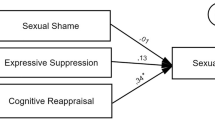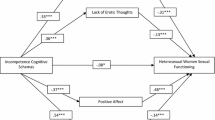Abstract
The relationship between automatic thoughts and emotions presented during sexual activity and their correlation with sexual arousal was investigated. A total of 491 individuals (163 women and 232 men without sexual problems and 47 women and 49 men with a DSM-IV diagnosis of sexual dysfunction) completed the Sexual Modes Questionnaire (SMQ; Nobre and Pinto-Gouveia, Journal of Sex Research, 40, 368–382, 2003). Results indicated several significant correlations among automatic thoughts, emotions, and sexual arousal. Erection concern thoughts in the men and failure/disengagement thoughts and lack of erotic thoughts in the women presented the most significant negative correlations with sexual arousal. Additionally, sadness and disillusion were positively related to these negative cognitions and negatively associated with sexual arousal in both sexes. On the other hand, pleasure and satisfaction were negatively associated with the above-mentioned negative cognitions and positively associated with subjective sexual arousal in both men and women. Overall, findings support the hypothesis that cognitive, emotional, and behavioral dimensions are closely linked and suggest a mode typical of sexual dysfunction composed of negative automatic thoughts, depressive affect, and low subjective sexual arousal.
Similar content being viewed by others
References
Adams, S. G., Dubbert, P. M., Chupurdia, K. M., Jones, A., Lofland, K. R., & Leermakers, E. (1996). Assessment of sexual beliefs and information in aging couples with sexual dysfunction. Archives of Sexual Behavior, 25, 249–260.
American Psychiatric Association. (1994). Diagnostic and statistical manual of mental disorders (4th ed.). Washington, DC: Author.
Bach, A. K., Brown, A. T., & Barlow, D. H. (1999). The effects of false negative feedback on efficacy expectancies and sexual arousal in sexually functional males. Behavior Therapy, 30, 79–95.
Baker, C., & De Silva, P. (1988). The relationship between male sexual dysfunction and belief in Zilbergeld’s myths: An empirical investigation. Sexual and Marital Therapy, 3, 229–238.
Barlow, D. H., Sakheim, D. K., & Beck, J. G. (1983). Anxiety increases sexual arousal. Journal of Abnormal Psychology, 92, 49–54.
Beck, A. T. (1996). Beyond belief: A theory of modes, personality and psychopathology. In P. M. Salkovskis (Ed.), Frontiers of cognitive therapy (pp. 1–25). New York: Guilford Press.
Beck, J. G., & Barlow, D. H. (1986). The effects of anxiety and attentional focus on sexual responding-II: Cognitive and affective patterns in erectile dysfunction. Behaviour Research and Therapy, 24, 19–26.
Beck, J. G., Barlow, D. H., Sakheim, D. K., & Abrahamson, D. J. (1987). Shock threat and sexual arousal: The role of selective attention, thought content, and affective states. Psychophysiology, 24, 165–172.
Byrne, D., & Schulte, L. (1990). Personality dispositions as mediators of sexual responses. Annual Review of Sex Research, 1, 93–117.
Cappelleri, J. C., Rosen, R. C., Smith, M. D., Mishra, A., & Osterloh, I. H. (1999). Diagnostic evaluation of the erectile function domain of the International Index of Erectile Function. Urology, 54, 346–351.
Creti, L., & Libman, E. (1989) Cognitions and sexual expression in the aging. Journal of Sex and Marital Therapy, 15, 83–101.
Dove, N. L., & Weiderman, M. W. (2000). Cognitive distraction and women’s sexual functioning. Journal of Sex and Marital Therapy, 26, 67–78.
Elliot, A. N., & O’Donohue, W. T. (1997). The effects of anxiety and distraction on sexual arousal in a nonclinical sample of heterosexual women. Archives of Sexual Behavior, 26, 607–624.
Farkas, G. M., Sine, L. F., & Evans, I. M. (1979). The effects of distraction, performance demand, stimulus explicitness, and personality on objective and subjective measures of male sexual arousal. Behaviour Research and Therapy, 17, 25–32.
Fichten, C. S., Spector, I., & Libman, E. (1988). Client attributions for sexual dysfunction. Journal of Sex and Marital Therapy, 14, 208–224.
Geer, J. H., & Fuhr, R. (1976). Cognitive factors in sexual arousal: The role of distraction. Journal of Consulting and Clinical Psychology, 44, 238–243.
Heiman, J. R. (1980). Female sexual response patterns: Interactions of physiological, affective, and contextual cues. Archives of General Psychiatry, 37, 1311–1316.
Heiman, J. R., & Rowland, D. L. (1983). Affective and physiological sexual response patterns: The effects of instructions on sexual functional and dysfunctional men. Journal of Psychosomatic Research, 27, 105–116.
Koukounas, E., & McCabe, M. P. (2001). Sexual and emotional variables influencing sexual response to erotica: A psychophysiological investigation. Archives of Sexual Behavior, 30, 393–408.
Laan, E., Everaerd, W., Van-Aanhold, M., & Rebel, M. (1993). Performance demand and sexual arousal in women. Behaviour Research and Therapy, 31, 25–35.
Meisler, A. W., & Carey, M. P. (1991). Depressed affect and male sexual arousal. Archives of Sexual Behavior, 20, 541–554.
Mitchell, W. B., DiBartolo, P. M., Brown, T. A., & Barlow, D. H. (1998). Effects of positive and negative mood on sexual arousal in sexually functional males. Archives of Sexual Behavior, 27, 197–207.
Nobre, P. J., & Pinto-Gouveia, J. (2003). Sexual modes questionnaire: Measure to assess the interaction between cognitions, emotions and sexual response. Journal of Sex Research, 40, 368–382.
Nobre, P. J., & Pinto-Gouveia, J. (in press). Differences in automatic thoughts presented during sexual activity between sexually functional and dysfunctional males and females. Cognitive Therapy and Research.
Nobre, P. J., & Pinto-Gouveia, J. (2006a). Cognitive schemas activated in negative sexual events and sexual dysfunction. Manuscript submitted for publication.
Nobre, P. J., & Pinto-Gouveia, J. (2006b). Dysfunctional sexual beliefs as vulnerability factors to sexual dysfunction. Journal of Sex Research, 43, 68–75.
Nobre, P. J., & Pinto-Gouveia, J. (2006c). Emotions during sexual activity: Differences between sexually functional and dysfunctional men and women. Archives of Sexual Behavior, 35, 491–499.
Nobre, P. J., Pinto-Gouveia, J., & Gomes, F. A. (2003). Sexual Dysfunctional Beliefs questionnaire: An instrument to assess sexual dysfunctional beliefs as vulnerability factors to sexual problems. Sexual and Relationship Therapy, 18, 171–204.
Nobre, P. J., Wiegel, M., Bach, A., Weisberg, R., Brown, T., Wincze, J., et al. (2004). Determinants of sexual arousal and the accuracy of its self-estimation in sexually functional males. Journal of Sex Research, 41, 363–371.
Palace, E. M. (1995). Modification of dysfunctional patterns of sexual response through autonomic arousal and false physiological feedback. Journal of Consulting and Clinical Psychology, 63, 604–615.
Palace, E. M., & Gorzalka, B. B. (1990). The enhancing effects of anxiety on arousal in sexually functional and dysfunctional women. Journal of Abnormal Psychology, 99, 403–411.
Przybyla, D. P. J., & Byrne, D. (1984). The mediating role of cognitive processes in self-reported sexual arousal. Journal of Research in Personality, 18, 43–54.
Rosen, R. C., Brown, C., Heiman, J., Leiblum, S., Meston, C., Shabsig, R., et al. (2000). The Female Sexual Function Index (FSFI): A multidimensional self-report instrument for the assessment of female sexual function. Journal of Sex and Marital Therapy, 26, 191–208.
Rosen, R. C., Riley, A., Wagner, G., Osterloh, I. H., Kirkpatrck, J., & Mishra, A. (1997). The International Index of Erectile Function (IIEF): A multidimensional scale for assessment of erectile dysfunction. Urology, 49, 822–830.
Rowland, D. L., Cooper, S. E., & Heiman, J. R. (1995). A preliminary investigation of affective and cognitive response in men before and after treatment in a sex therapy program. Journal of Sex and Marital Therapy, 21, 3–20.
Rowland, D. L., Cooper, S. E., & Slob, A. K. (1996). Genital and psychoaffective response to erotic stimulation in sexually functional and dysfunctional men. Journal of Abnormal Psychology, 105, 194–203.
Weisberg, R., Brown, T., Wincze, J. P., & Barlow, D. H. (2001). Causal attributions and male sexual arousal: The impact of attributions for a bogus erectile difficulty on sexual arousal, cognitions and affect. Journal of Abnormal Psychology, 110, 324–334.
Acknowledgments
This research is part of a doctoral dissertation presented by the first author to Faculdade de Psicologia e Ciências da Educaçço da Universidade de Coimbra, Coimbra, Portugal. The study was partially supported by a grant from PRODEP. The authors would like to thank to Allen Gomes, M.D., Hospitais da Universidade de Coimbra, Portugal, for making possible the collection of the clinical sample and also for his comments and suggestions. Thanks also to D. Rijo, M.A., C. Salvador, M.A., M. Lima, Ph.D., Faculdade de Psicologia, Universidade de Coimbra, Portugal; A. Gomes, M.A., L. Fonseca, M.A., A. Carvalheira, M.A., J. Teixeira, M.D., G. Santos, M.D., J. Quartilho, M.D., Ph.D., P. Abrantes, M.D., A. Canhão, M.D., Hospitais da Universidade de Coimbra, for their suggestions and help in data collection. Thanks also to participants who volunteered to participate in the study.
Author information
Authors and Affiliations
Corresponding author
Appendix A
Appendix A

Rights and permissions
About this article
Cite this article
Nobre, P.J., Pinto-Gouveia, J. Cognitions, Emotions, and Sexual Response: Analysis of the Relationship among Automatic Thoughts, Emotional Responses, and Sexual Arousal. Arch Sex Behav 37, 652–661 (2008). https://doi.org/10.1007/s10508-007-9258-0
Received:
Revised:
Accepted:
Published:
Issue Date:
DOI: https://doi.org/10.1007/s10508-007-9258-0




